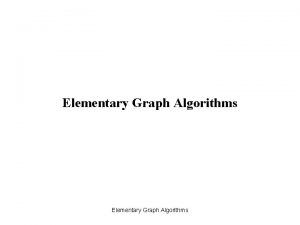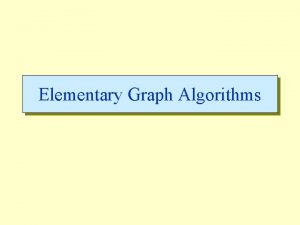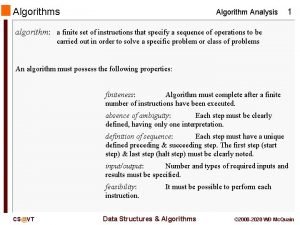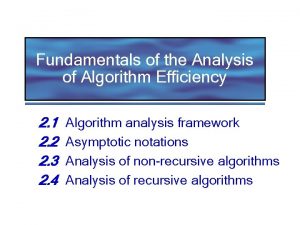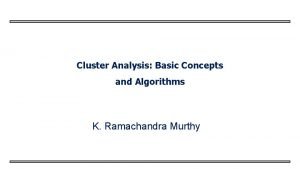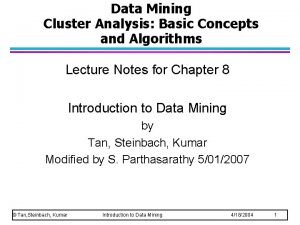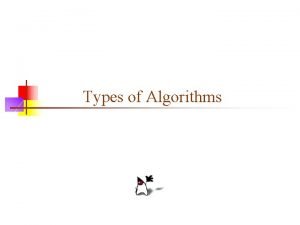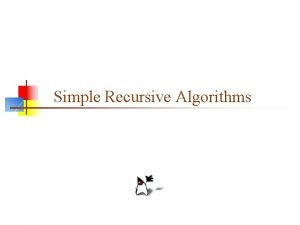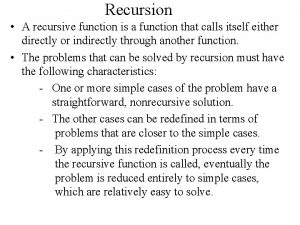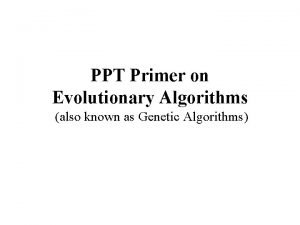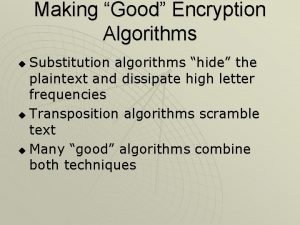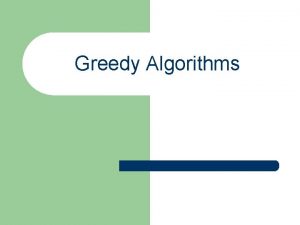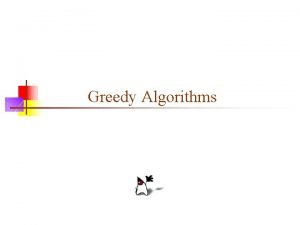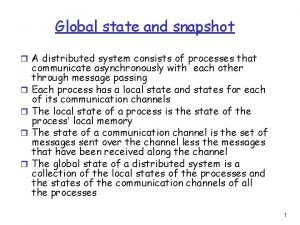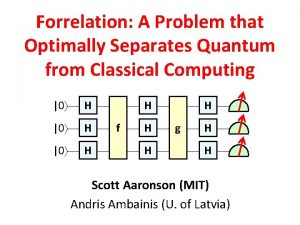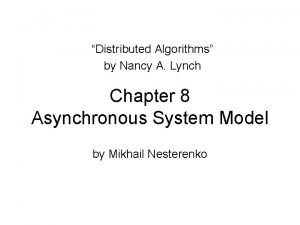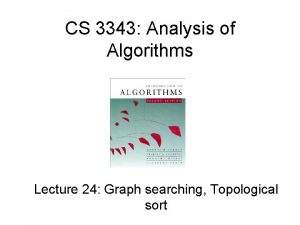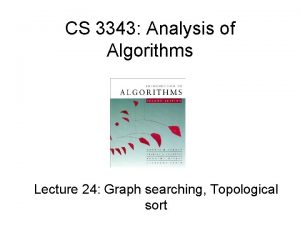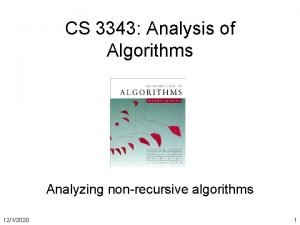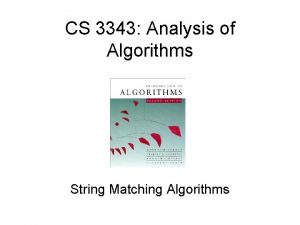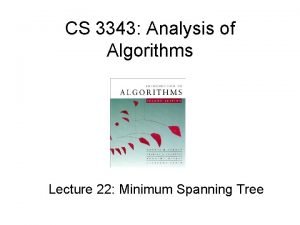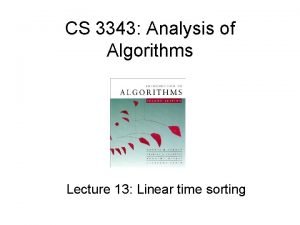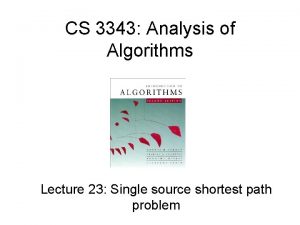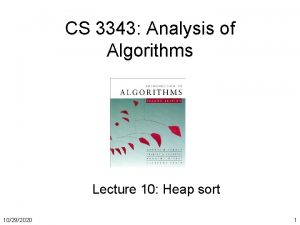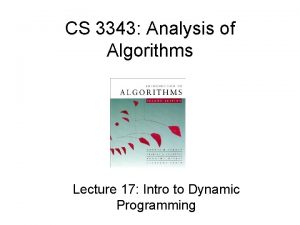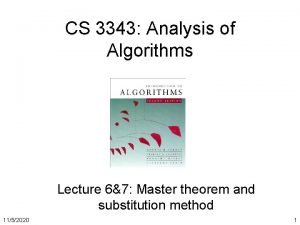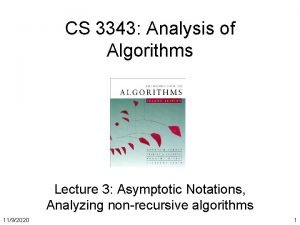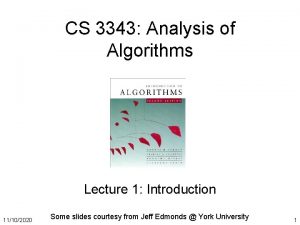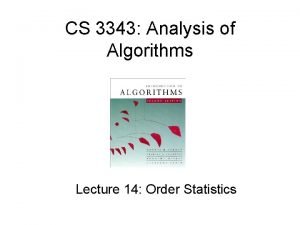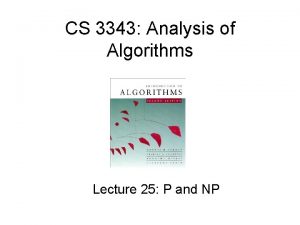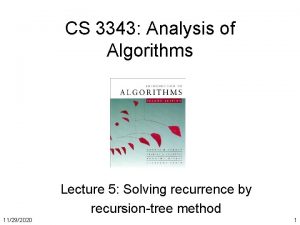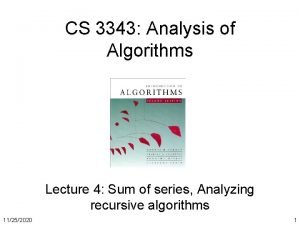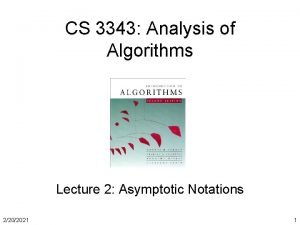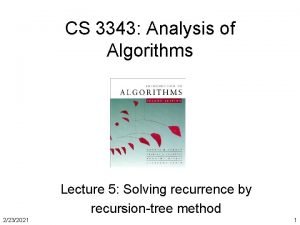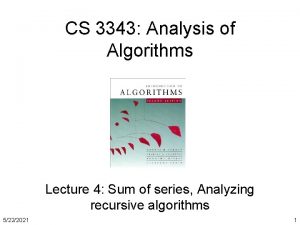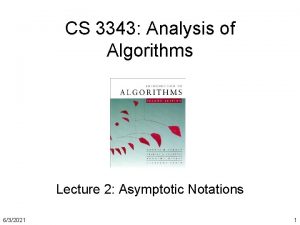CS 3343 Analysis of Algorithms Lecture 24 Graph

























































- Slides: 57

CS 3343: Analysis of Algorithms Lecture 24: Graph searching, Topological sort

Midterm 2 overview

Midterm 2 overview: overall

Semester overview D C B A

Review of MST and shortest path problem • Run Kruskal’s algorithm • Run Prim’s algorithm • Run Dijkstra’s algorithm 2 c 4 a 7 1 5 b 8 8 d 6 f 6 g 7 6 3 e

Graph Searching • Given: a graph G = (V, E), directed or undirected • Goal: methodically explore every vertex (and every edge) • Ultimately: build a tree on the graph – Pick a vertex as the root – Find (“discover”) its children, then their children, etc. – Note: might also build a forest if graph is not connected – Here we only consider that the graph is connected

Breadth-First Search • “Explore” a graph, turning it into a tree – Pick a source vertex to be the root – Expand frontier of explored vertices across the breadth of the frontier

Breadth-First Search • Associate vertex “colors” to guide the algorithm – White vertices have not been discovered • All vertices start out white – Grey vertices are discovered but not fully explored • They may be adjacent to white vertices – Black vertices are discovered and fully explored • They are adjacent only to black and gray vertices • Explore vertices by scanning adjacency list of grey vertices

Breadth-First Search BFS(G, s) { initialize vertices; // mark all vertices as white Q = {s}; // Q is a queue; initialize to s while (Q not empty) { u = Dequeue(Q); for each v adj[u] if (v. color == WHITE) { v. color = GREY; What does v. d represent? v. d = u. d + 1; What does v. p represent? v. p = u; Enqueue(Q, v); } u. color = BLACK; } }

Breadth-First Search: Example r s t u v w x y

Breadth-First Search: Example r s t u 0 v w x y Q: s

Breadth-First Search: Example r s t u 1 0 1 v w x y Q: w r

Breadth-First Search: Example r s t u 1 0 2 1 2 v w x y Q: r t x

Breadth-First Search: Example r s t u 1 0 2 2 1 2 v w x y Q: t x v

Breadth-First Search: Example r s t u 1 0 2 3 2 1 2 v w x y Q: x v u

Breadth-First Search: Example r s t u 1 0 2 3 2 1 2 3 v w x y Q: v u y

Breadth-First Search: Example r s t u 1 0 2 3 2 1 2 3 v w x y Q: u y

Breadth-First Search: Example r s t u 1 0 2 3 2 1 2 3 v w x y Q: y

Breadth-First Search: Example r s t u 1 0 2 3 2 1 2 3 v w x y Q: Ø

BFS: The Code Again BFS(G, s) { initialize vertices; Touch every vertex: Θ(n) Q = {s}; while (Q not empty) { u = Dequeue(Q); u = every vertex, but only once for each v adj[u] (Why? ) if (v. color == WHITE) { v = every vertex v. color = GREY; that appears in v. d = u. d + 1; some other vert’s v. p = u; Enqueue(Q, v); adjacency list Total: Θ(m) } u. color = BLACK; } What will be the running time? } Total running time: Θ(n+m)

Depth-First Search • Depth-first search is another strategy for exploring a graph – Explore “deeper” in the graph whenever possible – Edges are explored out of the most recently discovered vertex v that still has unexplored edges – When all of v’s edges have been explored, backtrack to the vertex from which v was discovered

Depth-First Search • Vertices initially colored white • Then colored gray when discovered • Then black when finished

Depth-First Search: The Code DFS(G) { for each vertex u G->V { u->color = WHITE; } time = 0; for each vertex u G->V { if (u->color == WHITE) DFS_Visit(u); } } DFS_Visit(u) { u->color = GREY; time = time+1; u->d = time; for each v u->Adj[] { if (v->color == WHITE) DFS_Visit(v); } u->color = BLACK; time = time+1; u->f = time; }

Depth-First Search: The Code DFS(G) { for each vertex u G->V { u->color = WHITE; } time = 0; for each vertex u G->V { if (u->color == WHITE) DFS_Visit(u); } } DFS_Visit(u) { u->color = GREY; time = time+1; u->d = time; for each v u->Adj[] { if (v->color == WHITE) DFS_Visit(v); } u->color = BLACK; time = time+1; u->f = time; } What does u->d represent?

Depth-First Search: The Code DFS(G) { for each vertex u G->V { u->color = WHITE; } time = 0; for each vertex u G->V { if (u->color == WHITE) DFS_Visit(u); } } DFS_Visit(u) { u->color = GREY; time = time+1; u->d = time; for each v u->Adj[] { if (v->color == WHITE) DFS_Visit(v); } u->color = BLACK; time = time+1; u->f = time; } What does u->f represent?

Depth-First Search: The Code DFS(G) { for each vertex u G->V { u->color = WHITE; } time = 0; for each vertex u G->V { if (u->color == WHITE) DFS_Visit(u); } } DFS_Visit(u) { u->color = GREY; time = time+1; u->d = time; for each v u->Adj[] { if (v->color == WHITE) DFS_Visit(v); } u->color = BLACK; time = time+1; u->f = time; } Will all vertices eventually be colored black? (How about in BFS? )

Depth-First Search: The Code DFS(G) { for each vertex u G->V { u->color = WHITE; } time = 0; for each vertex u G->V { if (u->color == WHITE) DFS_Visit(u); } } DFS_Visit(u) { u->color = GREY; time = time+1; u->d = time; for each v u->Adj[] { if (v->color == WHITE) DFS_Visit(v); } u->color = BLACK; time = time+1; u->f = time; } What will be the running time?

Depth-First Search: The Code DFS(G) { for each vertex u G->V { u->color = WHITE; } time = 0; for each vertex u G->V { if (u->color == WHITE) DFS_Visit(u); } } DFS_Visit(u) { u->color = GREY; time = time+1; u->d = time; for each v u->Adj[] { if (v->color == WHITE) DFS_Visit(v); } u->color = BLACK; time = time+1; u->f = time; } How many times will DFS_Visit() be called?

Depth-First Search: The Code DFS(G) { for each vertex u G->V { u->color = WHITE; } time = 0; for each vertex u G->V { if (u->color == WHITE) DFS_Visit(u); } } DFS_Visit(u) { u->color = GREY; time = time+1; u->d = time; for each v u->Adj[] { if (v->color == WHITE) DFS_Visit(v); } u->color = BLACK; time = time+1; u->f = time; } How much time is needed within each DFS_Visit()?

Depth-First Search: The Code DFS(G) { for each vertex u G->V { u->color = WHITE; } time = 0; for each vertex u G->V { if (u->color == WHITE) DFS_Visit(u); } } DFS_Visit(u) { u->color = GREY; time = time+1; u->d = time; for each v u->Adj[] { if (v->color == WHITE) DFS_Visit(v); } u->color = BLACK; time = time+1; u->f = time; } So, running time of DFS = O(V+E)

DFS Example source vertex

DFS Example source vertex d f 1 | | | |

DFS Example source vertex d f 1 | | 2 | | |

DFS Example source vertex d 1 | f | 2 | | | 3 | | |

DFS Example source vertex d f 1 | | 2 | | | 3 | 4 | |

DFS Example source vertex d f 1 | | 2 | | | 3 | 4 5 | |

DFS Example source vertex d f 1 | | 2 | | | 3 | 4 5 | 6 |

DFS Example source vertex d f 1 | | 2 | 7 | | 3 | 4 5 | 6 |

DFS Example source vertex d f 1 | 8 | 2 | 7 | | 3 | 4 5 | 6 |

DFS Example source vertex d f 1 | 8 | 2 | 7 | 9 | 3 | 4 5 | 6 What is the structure of the grey vertices? What do they represent? |

DFS Example source vertex d f 1 | 8 | 2 | 7 | 9 |10 3 | 4 5 | 6 |

DFS Example source vertex d f 1 | 8 |11 2 | 7 | 9 |10 3 | 4 5 | 6 |

DFS Example source vertex d f 1 |12 8 |11 2 | 7 | 9 |10 3 | 4 5 | 6 |

DFS Example source vertex d f 1 |12 8 |11 2 | 7 13| 9 |10 3 | 4 5 | 6 |

DFS Example source vertex d f 1 |12 8 |11 2 | 7 13| 9 |10 3 | 4 5 | 6 14|

DFS Example source vertex d f 1 |12 8 |11 2 | 7 13| 9 |10 3 | 4 5 | 6 14|15

DFS Example source vertex d f 1 |12 8 |11 2 | 7 13|16 9 |10 3 | 4 5 | 6 14|15

DFS and cycles in graph • A graph G is acyclic iff a DFS of G yields no back edges source vertex d 1 | f | 2 | | | 3 | | |

Directed Acyclic Graphs • A directed acyclic graph or DAG is a directed graph with no directed cycles: Acyclic Cyclic

Topological Sort • Topological sort of a DAG: – Linear ordering of all vertices in graph G such that vertex u comes before vertex v if edge (u, v) G • Real-world example: getting dressed

Getting Dressed Underwear Socks Watch Pants Shoes Shirt Belt Tie Jacket

Getting Dressed Underwear Socks Watch Pants Shoes Shirt Belt Tie Jacket Socks Underwear Pants Shoes Watch Shirt Belt Tie Jacket

Topological Sort Algorithm Topological-Sort() { // condition: the graph is a DAG Run DFS When a vertex is finished, output it Vertices are output in reverse topological order } • Time: O(V+E) • Correctness: Want to prove that (u, v) G u f > v f

Correctness of Topological Sort • Claim: (u, v) G u f > v f – When (u, v) is explored, u is grey • v = grey (u, v) is back edge. Contradiction (Why? ) • v = white v becomes descendent of u v f < u f (since must finish v before backtracking and finishing u) • v = black v already finished v f < u f

Another Algorithm • Store vertices in a priority min-queue, with the in-degree of the vertex as the key • While queue is not empty • Extract minimum vertex v, and give it next number • Decrease keys of all adjacent vertices by 1 0 0 2 1 1 4 3 5 1 2 7 6 3 1 8 9 2 1

Another Algorithm • Store vertices in a priority min-queue, with the in-degree of the vertex as the key • While queue is not empty • Extract minimum vertex v, and give it next number • Decrease keys of all adjacent vertices by 1 0 0 1 10 3 2 4 5 01 2 10 7 10 6 3210 8 9 201 10

Topological Sort Runtime: • O(|V|) to build heap + O(|E|) DECREASE-KEY ops O(|V| + |E| log |V|) with a binary heap O(|V|2) with an array Compare to DFS: O(|V|+|E|)
 Analysis of algorithms lecture notes
Analysis of algorithms lecture notes Introduction to algorithms lecture notes
Introduction to algorithms lecture notes 01:640:244 lecture notes - lecture 15: plat, idah, farad
01:640:244 lecture notes - lecture 15: plat, idah, farad White path theorem
White path theorem When graphs are life
When graphs are life Elementary graph algorithms
Elementary graph algorithms Undirected graph algorithms
Undirected graph algorithms Graph neural network lecture
Graph neural network lecture 1001 design
1001 design An introduction to the analysis of algorithms
An introduction to the analysis of algorithms Analyze algorithm
Analyze algorithm Association analysis: basic concepts and algorithms
Association analysis: basic concepts and algorithms Algorithm output
Algorithm output Algorithm analysis examples
Algorithm analysis examples Analysis of algorithms
Analysis of algorithms Steps in mathematical analysis of non recursive algorithm
Steps in mathematical analysis of non recursive algorithm Cluster analysis: basic concepts and algorithms
Cluster analysis: basic concepts and algorithms Randomized algorithms and probabilistic analysis
Randomized algorithms and probabilistic analysis Introduction of design and analysis of algorithms
Introduction of design and analysis of algorithms Cluster analysis basic concepts and algorithms
Cluster analysis basic concepts and algorithms Cjih
Cjih Goals of analysis of algorithms
Goals of analysis of algorithms Cluster analysis basic concepts and algorithms
Cluster analysis basic concepts and algorithms Binary search in design and analysis of algorithms
Binary search in design and analysis of algorithms Introduction to the design and analysis of algorithms
Introduction to the design and analysis of algorithms Competitive analysis algorithms
Competitive analysis algorithms Design and analysis of algorithms
Design and analysis of algorithms Design and analysis of algorithms
Design and analysis of algorithms Cluster analysis basic concepts and algorithms
Cluster analysis basic concepts and algorithms Comp 482
Comp 482 Exploratory data analysis lecture notes
Exploratory data analysis lecture notes Sensitivity analysis lecture notes
Sensitivity analysis lecture notes Factor analysis lecture notes
Factor analysis lecture notes Streak plate
Streak plate Power system analysis lecture notes
Power system analysis lecture notes Line graph graph theory
Line graph graph theory Resource allocation graph and wait for graph
Resource allocation graph and wait for graph Computational thinking algorithms and programming
Computational thinking algorithms and programming Types of algorithm
Types of algorithm Simple recursive algorithms.
Simple recursive algorithms. Handling patients
Handling patients Recursive function in c
Recursive function in c Types of randomized algorithms
Types of randomized algorithms Process mining algorithms
Process mining algorithms Evolutionary algorithms ppt
Evolutionary algorithms ppt Nature-inspired learning algorithms
Nature-inspired learning algorithms Metaheuristic algorithms
Metaheuristic algorithms Making good encryption algorithms
Making good encryption algorithms Statistical algorithms
Statistical algorithms Ajit diwan
Ajit diwan Disadvantages of greedy algorithm
Disadvantages of greedy algorithm List of greedy algorithms
List of greedy algorithms What is global state in distributed system
What is global state in distributed system Forrelation
Forrelation Aprioti
Aprioti Dsp programming tutorial
Dsp programming tutorial Distributed algorithms nancy lynch
Distributed algorithms nancy lynch [email protected]
[email protected]



